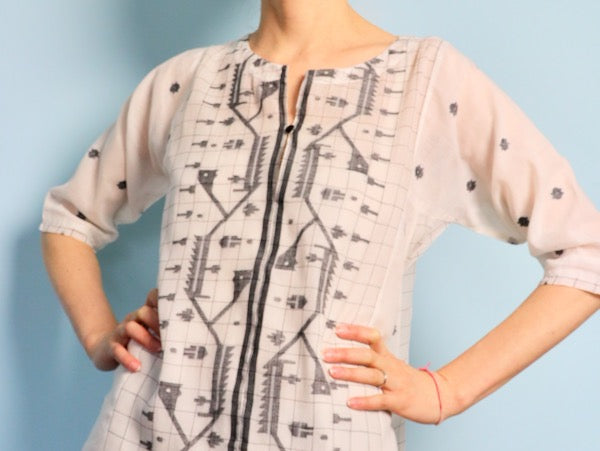
The moment I set eyes on a certain beautiful dress from Good Earth, an Indian luxury lifestyle brand (click here to see it), I yearned for it. The traditional jamdani-woven design on the cotton fabric, as well as the fabric’s extraordinary lightness, epitomize all that is wonderful about Indian handloom textiles. Honestly, I knew I would never buy it since I rarely purchase garments that I can sew. But how I would love to make such a beautiful thing! Imagine my delight when by chance I found a similar jamdani fabric the next time I was in India. The fabric had an intricate border along one selvedge and checks across the rest of the yardage. (This was four or five years ago, before I started Loom & Stars.)

As it happened, I already had the perfect pattern. The dress is more or less just a kamiz, a traditional garment of the Indian Subcontinent with a simple shape, which is part of Folkwear’s “Jewels of India” pattern. (The pattern also includes a great kurta or tunic for both men and women.) I had made the kamiz before and knew it would be easy to modify for this design. Here's the pattern illustration:

The inspiration garment appeared to have the same basic lines as the kamiz pattern. Both front and back were rectangular panels, the front consisting of two pieces of the border design stitched together down center front, with a buttoned opening at the neck. When I first used this pattern some years ago, I found that it had generous ease and a nice A-line flare from the bustline. This time I cut the front and back panels slightly narrower in order to reduce the ease a bit, though it is still quite loosely fitted.

As you can see in the pattern illustration, the Folkwear kamiz has a wedge-shaped panel adding flare at each side of the central rectangles, front and back. I divided this wedge into two smaller pieces in order to incorporate the contrasting spotted fabric. Cutting this contrast fabric was a pleasing exercise in no-waste sewing: the triangular side panels all nested together perfectly and left just enough room for the sleeve pieces, with only a few tiny scraps left over. This is reminiscent of the way many traditional garments use cloth with maximal efficiency because all cloth used to be handwoven and precious. (Something we are now beginning to appreciate again!)

For the contrast fabric I chose our Star Flower handloom jamdani cotton (also known as “cats wearing bowties”) which is similar to what was used in the inspiration garment. My two fabrics are not quite the same weight or shade of white, but this isn't noticeable when worn because a slip is required underneath due to the transparency of the fabric, and that evens out the color.

Fine cotton threads and needles are the best choice when sewing these super-light handlooms since the fabric can be delicate. With a spool of Aurifil cotton thread and a very fine machine needle (size 70/9) on my ancient sewing machine, the actual stitching of the dress was quick and easy. It was mostly long straight French seams and the woven lines in the fabric provided helpful guidelines.

With a few other design changes, the Folkwear pattern perfectly captured the spirit the inspiration garment: I cut the neckline a little wider and rounder, and I added a small button at the center front neck opening. A bit of fusible stay tape around the neckline helps to stabilize that area but does not show through. I edge-stitched and topstitched the facings, too, which also adds some stability. Notice the small underarm gusset which allows for a little extra movement.

A kamiz is essentially a simply-shaped dress, with minimal shaping and straight seamlines, which can serve as a blank slate to be modified in any number of ways. For example, to add more fullness to the pattern, add more gores to the side panels rather than splitting them into pieces. (I would have if I’d had more fabric, and it looks like the inspiration dress had more, too.) Or make the panels from triangles with more flare at the base, or even broaden the triangles into trapezoids and then gather them along the top to fit into the allotted space. The basic structure can have many variations.

Fabrics with border designs like this are always fun to work with. We try to keep a few on hand in the shop both because we love them — they’re beautiful testaments to the skills of the weavers who made them — and because they’re so inspiring for the sewist planning a garment. We’ve collected some favorite designs on our Pinterest page to help you envision the possibilities.

I find these handloom weaves absolutely enchanting. Jamdani fabrics in particular have a quality of weightlessness and movement which I tried to capture in my dress. Looking at my dress, or the one that inspired it, our eyes are struck first by the beauty of the textiles. But in fact, as we discovered, what looks like a fairly elaborate garment actually has a very straightforward structure. Garments with a relatively uncomplicated cut like this are characteristic of traditional clothing in many cultures and make the most of precious textiles. That’s right in line with current ideas of minimizing fabric waste. It’s also a great reminder that a sewing pattern doesn’t need to have fancy seamlines or intricate details — if you have a wonderful piece of fabric and use it creatively, you’ve got what you need to make a fabulous garment!

Learn about how jamdani handloom fabrics are made here, and shop for them here.

